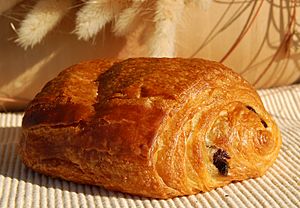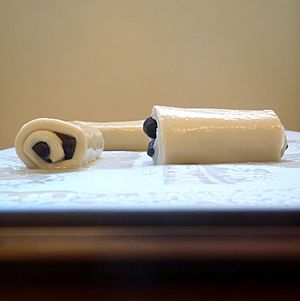Pain au chocolat facts for kids

Pain au chocolat
|
|
| Alternative names | Chocolate bread, couque au chocolat, pain au chocolat, petit pain |
|---|---|
| Type | Viennoiserie sweet roll |
| Place of origin | France |
| Serving temperature | Hot or cold |
| Main ingredients | Yeast-leavened dough, chocolate |
A Pain au chocolat (pronounced pan oh shok-oh-LAH), which means "chocolate bread" in French, is a yummy sweet roll. In some places, especially in southwestern France and Quebec, Canada, it's called a chocolatine (pronounced shok-oh-lah-TEEN).
This tasty treat is a type of viennoiserie, which are baked goods made from a special kind of dough. It's shaped like a small rectangle and has one or two pieces of dark chocolate baked right in the middle.
Pain au chocolat is made with the same layered dough as a croissant. This dough is very light and flaky, almost like a puff pastry. You can often buy them warm from the oven in French bakeries and supermarkets. They are a popular breakfast or snack item.
What's in a Name?
The name for this chocolate pastry can change depending on where you are!
- In central France, southern France, and in Paris, people usually say pain au chocolat.
- In the Hauts-de-France region and in Alsace, they might call it petit pain au chocolat or just petit pain.
- In southwestern France (like Nouvelle-Aquitaine and Occitanie) and in Quebec, Canada, the word chocolatine is used.
Other countries also have their own names for it:
- In Belgium, it's sometimes called couque au chocolat.
- In Germany, they are often called Schokoladencroissant, which means "chocolate croissant."
- In the United States and English Canada, people usually just say "chocolate croissants."
- In the Netherlands, it's known as a chocoladebroodje.
- In Portugal and Spain, you might find them called napolitanas.
- In Mexico, they are also known as chocolatines.
- In El Salvador and Brazil, they are called croissant de chocolate.
- In Australia and New Zealand, they are commonly known as "chocolate croissants."
You can find these delicious pastries in most bakeries, supermarkets, and cafés in many countries around the world!
A Sweet History
Some stories say that Marie Antoinette brought the croissant to France. However, both croissants and pains au chocolat are actually much newer inventions.
The word "croissant" (which means "crescent" because of its moon shape) first appeared in a French dictionary in 1863. The type of pastry called viennoiserie was introduced in the early 1800s. This happened when an Austrian officer named August Zang and an Austrian aristocrat named Ernest Schwarzer opened a bakery in Paris. They brought the baking style from Vienna, Austria, to France.
At first, croissants and pains au chocolat were made from a dough similar to brioche. But over time, bakers started using a buttery, flaky dough, which is like a pâte feuilletée. This is the delicious, layered dough we know today!
See also
 In Spanish: Napolitana (dulce) para niños
In Spanish: Napolitana (dulce) para niños


